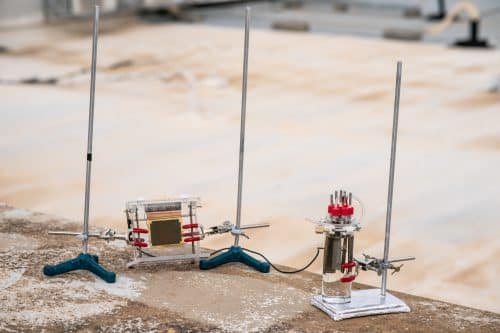Researchers at the Technion have developed an innovative prototype system for the efficient and safe production of hydrogen using only solar energy. The study, published in the journal Joule from the Cell group

Credit: Technion spokespeople
Researchers at the Technion have developed a prototype system for the efficient and safe production of hydrogen using only solar energy. The research, published in the journal Joule from the Cell group, was led by doctoral student Abigail Landman from the Grand Energy Program, together with master's student Rowan Halavi from the Faculty of Materials Science and Engineering. The research was conducted under the joint direction of Prof. Gidi Gerder from the Faculty of Chemical Engineering and Prof. Avner Rothschild from the Faculty of Materials Science and Engineering, and Prof. Adelio Mendes and Dr. Paula Diaz from the University of Porto in Portugal are partners in it.
The innovative system contains a two-layer solar device (Tandem cell), which enables more efficient utilization of the light spectrum: part of the solar radiation is absorbed by the upper layer, which is made of semi-transparent iron oxide; And the radiation that is not absorbed by this layer passes through it and is later absorbed by a photovoltaic cell. Together, the two layers provide the system with the energy needed to break down the water.
from theory to application
The innovative system is a continuation of a theoretical breakthrough by the Technion research team, which was presented in an article published in Nature Materials in March 2017. In the same article, the researchers presented a paradigmatic change in hydrogen production: instead of one production cell where the water breaks down into hydrogen and oxygen, the researchers developed a system where the hydrogen and oxygen are created in two cells completely different. This development is important partly because mixing the oxygen and hydrogen creates an explosive and dangerous interaction. The researchers presented the proof of feasibility in a laboratory system powered by a conventional power source.
Now, in the current study published in Joule, the researchers implemented the theory in applied development - a prototype photoelectrochemical system that produces hydrogen and oxygen in two separate cells using only sunlight. As part of the experiment, about 80 working hours were conducted (10 days of about 8 hours), which demonstrated the effectiveness of the system in natural sunlight. The experiment was conducted at the Faculty of Chemical Engineering at the Technion.
Background for the research
Hydrogen is a highly sought-after substance in many areas of our lives. Most of the hydrogen produced today is used to produce ammonia for the production of fertilizers essential to modern agriculture. In addition, hydrogen is one of the leading competitors in the field of alternative fuels, especially in the context of vehicle propulsion. In the transportation context, hydrogen has several advantages over mineral-based fuels:
- it is possible to extract water from green energies such as solar energy, thus reducing dependence on fossil fuels and dependence on countries rich in oil reserves;
- Producing hydrogen from water allows the storage of green energies, which are not available at all hours of the day
- Unlike diesel and gasoline engines that emit a lot of pollution into the air, the only byproduct of hydrogen engines is water.
Today, hydrogen is produced in the world, most of it as a whole, from natural gas, in a process that emits carbon dioxide (CO2) whose environmental damages are known. An alternative production method is electrolysis - splitting water (H2O) into hydrogen (H2) and oxygen (O2). The electrolysis process was developed more than two hundred years ago, in 1800, but since then many electrolysis technologies have not been developed. In recent years, with the essential transition to alternative energies, it is clear that the electrolysis processes must be perfected to fit these energy sources.
Against this background, the photoelectrochemical process was developed, which breaks down water directly by solar radiation. But even here there are various technological challenges. For example, the production of hydrogen in the accepted way in electrolysis - the breaking down of water into hydrogen and oxygen in the same production cell - involves risk because the meeting between hydrogen and oxygen leads to an explosion. Furthermore, in vast solar fields it is very difficult to produce hydrogen in this configuration. Hence the importance of the current breakthrough presented in Joule.
The researchers hope that factors in academia and industry will continue and advance the system into a commercial product.
The research was supported by the Nancy and Steven Grand Technion Energy Program (GTEP), an Ed Suttle grant, the Adelis Foundation, the Ministry of Energy and the European Commission (two ERC grants) and the National Science Foundation's PAT Center of Excellence.
For the article in the journal Joule
A video explaining the research and introducing the new system

5 תגובות
Come on Danny, it's time to build a startup on this kit. Send me a link to the Aliexpress product, leave it to me.
Unbelievable, the academy pours hundreds of thousands of shekels.
About the Mali Express kit for high school students that costs NIS 20
The research was supported by the Nancy and Steven Grand Technion Energy Program (GTEP), an Ed Suttle grant, the Adelis Foundation, the Ministry of Energy and the European Commission (two ERC grants) and the National Science Foundation's PAT Center of Excellence.
Where was the discovery???? We will not make any innovation
Kudos to the developers, the highlight is the apparently safe splitting of hydrogen and oxygen separately, not the solar echo.
Ships that will never anchor cities and villages in the depths of the sea